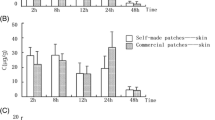Abstract
Atrazine is an extensively used herbicide in the USA. Our objective was to determine the absorption and metabolism (detoxification) of atrazine in human skin. Percutaneous absorption of atrazine in human skin from four sources was examined utilizing a flow-through in-vitro diffusion system. About 16.4% of the applied dose was absorbed by the skin. Radioactivity in the receptor fluid at 20 h was less than 5% of the administered dose. The highest concentration of the applied dose was found in the skin supernates, where 12.0% of the dose (68 nmol) was recovered. Some metabolites of atrazine were identified by thin layer and high pressure liquid chromatography after extraction of receptor fluid and the skin supernates. Two metabolites of atrazine [2-chloro-4-ethylamino-6-amino-striazine (desisopropylatrazine) and 2-chloro-4,6-diamino-s-triazine] were found in the receptor fluid and the skin supernates. An additional metabolite (2-chloro-4-amino-6-isopropylamino-s-triazine) was found in the skin supernates. Since desisopropylatrazine represented about 50% of the total metabolites formed during percutaneous absorption, cleavage of the N-isopropyl to the amino product was a key step in the metabolism of atrazine. Further metabolism may proceed by cleavage of the N-deethyl group to give totally dealkylated atrazine. The biotransformation of atrazine was studied in skin microsomal fraction supplemented with an NADPH-generating system. In analogy to metabolism during percutaneous absorption, atrazine was metabolized to its deisopropyl and deethylpropyl derivatives. In addition, 2-hydroxy derivatives of atrazine were formed by the skin microsomal fractions. The biotransformation of atrazine by skin microsomal enzymes indicates the metabolic capacity of the tissue. Cutaneous metabolism of atrazine may be an additional route by which human skin detoxifies the pesticide following topical exposure.
Similar content being viewed by others
References
Ademola JI (1992) Cutaneous biotransformation of theophylline. J Invest Dermatol 98: 310–314
Bradway DE, Moseman RF (1982) Determination of urinary residue level of the N-dealkyl metabolites of triazine herbicides. J Agric Food Chem 30: 244–247
Bronaugh BL (1985) Determination of percutaneous absorption by in vitro techniques. In: Bronaugh RL, Maibach HI (eds) Percutaneous Absorption, vol 6, Marcel Dekker, New York, Basle, pp 267–279
Frank R, Sirons GJ (1985) Dissipation of atrazine residues from soils. Bull Environ Contamin Toxicol 34: 541–548
Catenacci G, Maroni M, Cottica D, Pozzoli L (1990) Assessment of human exposure to atrazine through the determination of free atrazine in urine Bull Environ Contam Toxicol 44: 1–7
Graham MJ, Williams FM, Rettie AE, Rawlins MD (1987) Aldrin metabolism in the skin. In: Shroot B, Schaefer H (eds) Pharmacololgy of the skin, Vol. 1. Karger Basel, pp 252–255
Gummer CL, Hinz RS, Maibach HI (1987) The skin cell: a design update. Int J Pharmacol 40: 101–104
Ikonen R, Kangas J, Savolein H (1988) Urinary atrazine metabolites as indicators for rat and human exposure to atrazine. Toxicol Lett 44: 109–112
Means JC, Plewa MJ, Gentile JM (1988) Assessment of the mutagenicity of fractions from s-triazine-treated Zea mays. Mutat Res 197: 325–336
Muir DCC, Yoo JY, Baker BE (1978) Residues of atrazine and N-deethylated atrazine in water from fine agricultural water-sheds in Quebec. Arch Environ Contam Toxicol 7: 221–235
Purkayatstha R, Cochrane WP (1973) Analysis of atrazine herbicides in environmental samples. J Agric Food Chem 21: 95–100
Pratt JR, Bowers NJ, Neiderlehhner BR, Cairns J Jr (1988) Effects of atrazine in fresh H2O microbial communities. Arch Environ Contam Toxicol 17: 449–457
US Department of Agriculture (1983) Econres sero inputs outlook and situation. Inputs, outlook and situation — 2
Author information
Authors and Affiliations
Rights and permissions
About this article
Cite this article
Ademola, J.I., Sedik, L.E., Wester, R.C. et al. In vitro percutaneous absorption and metabolism in man of 2-chloro-4-ethylamino-6-isopropylamine-s-triazine (Atrazine). Arch Toxicol 67, 85–91 (1993). https://doi.org/10.1007/BF01973676
Received:
Accepted:
Issue Date:
DOI: https://doi.org/10.1007/BF01973676




